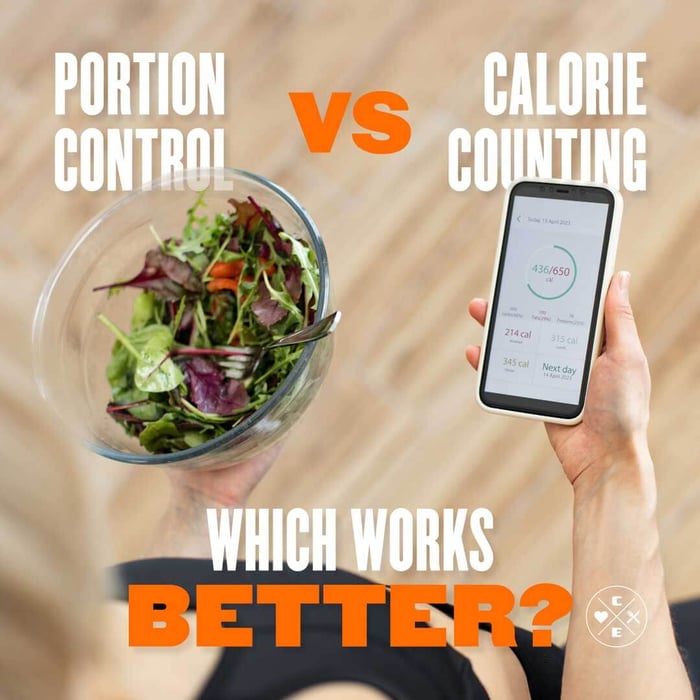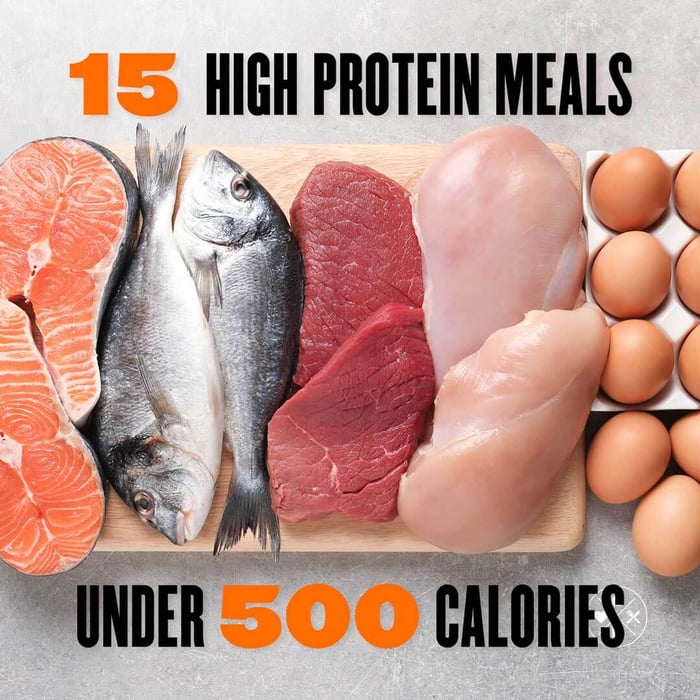
Portion Control vs. Calorie Counting: Which Works Better?
Jason Nista
Healthy Recipes
|
Weight Loss
|
Healthy Lifestyle
8 minute read
Portion control and calorie counting are two effective ways to manage weight. Which one works better? It depends on your goals and lifestyle.
Portion Control: Focuses on eating the right serving sizes. It's simple, quick, and great for building healthy habits without detailed tracking.
Calorie Counting: Tracks the energy in everything you eat. It's precise, flexible, and ideal for those with specific weight loss or fitness goals.
Both methods can lead to successful weight management. Studies show that consistent tracking - whether through portion sizes or calorie counts - helps people lose more weight. Combining both approaches might be the most practical solution for many.
Quick Comparison
| Aspect | Portion Control | Calorie Counting |
|---|---|---|
| Accuracy | Moderate (uses visual guides) | High (precise tracking) |
| Time Investment | Low (minimal tracking) | High (requires logging) |
| Learning Curve | Simple | Challenging |
| Flexibility | Limited (fixed portions) | High (adjustable intake) |
| Best Suited For | Beginners, busy individuals | Detail-oriented people, specific goals |
The best method is the one you can stick to. For some, combining portion control for everyday meals with calorie counting for occasional tracking works best.
What's Better For Weight Loss: Calorie Counting or Portion Control
Basics of Portion Control and Calorie Counting
Portion Control Explained
Portion control is all about managing how much you eat by sticking to recommended serving sizes for different food groups. Tools like portion plates and color-coded containers make this easier by assigning portions for proteins, vegetables, carbs, and fats. This approach eliminates the need for calorie counting or doing detailed math while planning meals.
"Portion control offers a practical way to manage food intake without complex tracking", says Shetal Desai Rautela, Registered Dietitian [3].
Calorie Counting Explained
Calorie counting provides a more precise way to monitor your energy intake. Thanks to modern apps, tracking calories is now easier with features like barcode scanning and extensive food databases. Research shows that people who consistently count calories lose about 7 pounds (3.3 kg) more than those who don’t track their intake [2]. This method relies on food labels and nutrition databases to ensure accuracy.
Here are some common tools for calorie tracking:
| Tool Type | Examples |
|---|---|
| Mobile Apps | MyFitnessPal, LoseIt! |
| Food Labels | Calorie and nutrient info |
| Digital Scales | For measuring portions |
Pros and Cons of Each Method
Pros and Cons of Portion Control
Using pre-measured containers simplifies eating habits, making it a practical choice for those with busy schedules. It encourages awareness of portion sizes without requiring complex calculations or constant tracking.
On the flip side, this approach has its limitations. Standardized portions might not work well for athletes who need precise macronutrient tracking or for individuals with health conditions like diabetes, where detailed nutritional data is crucial.
Pros and Cons of Calorie Counting
Calorie counting offers precise control over daily energy intake, making it a popular choice for achieving weight loss goals. Tools like MyFitnessPal streamline the process with features like barcode scanning and extensive food databases.
However, calorie counting can be time-consuming, requiring consistent meal logging. It may also lead to an unhealthy fixation on calorie numbers, potentially overshadowing the importance of overall food quality.
Comparison Table: Portion Control vs. Calorie Counting
| Aspect | Portion Control | Calorie Counting |
|---|---|---|
| Accuracy | Moderate - uses visual guides and containers | High - precise calorie tracking |
| Time Investment | Low - minimal daily tracking needed | High - requires consistent logging |
| Learning Curve | Simple - intuitive serving sizes | Challenging - demands detailed tracking |
| Flexibility | Limited - fixed portion sizes | High - adjustable daily intake |
| Long-term Sustainability | High - develops natural portion awareness | Moderate - may lead to tracking fatigue |
| Best Suited For | Beginners and busy individuals | Detail-oriented people and specific weight goals |
Clean Eatz Kitchen showcases how both methods can work together by offering pre-portioned meals under 600 calories. This combination supports portion awareness while keeping calorie goals in check.
"Harvard Health suggests estimating calorie needs and focusing on nutrient-dense foods rather than obsessing over exact numbers" [4].
Choosing the right method depends on individual goals and lifestyle, but tools and resources can make either approach easier to follow.
sbb-itb-1989a25
Tools and Applications for Both Methods
Tools for Portion Control
Portion control becomes easier with tools like color-coded containers and portion plates. These tools provide pre-measured sections to guide balanced meals. For example, the USDA's MyPlate system uses simple visuals to recommend filling half your plate with vegetables, making it straightforward to balance your meals.
Meal delivery services, such as Clean Eatz Kitchen, also support portion control by providing pre-portioned meals under 600 calories. These options cater to various dietary preferences and take the guesswork out of measuring.
Tools for Calorie Counting
Technology has made calorie counting more efficient than ever. Apps like MyFitnessPal and Cronometer streamline the process with features like barcode scanning and extensive food databases. These tools make tracking calories accurate and hassle-free.
Here’s a quick comparison of some key features:
| Feature | Example | Benefit |
|---|---|---|
| Barcode Scanner | MyFitnessPal | Makes food logging quick and easy |
| Food Database | Cronometer | Offers reliable nutritional data |
| Meal Planning | Pre-logged templates | Speeds up tracking for common meals |
| Progress Tracking | Visual charts | Helps monitor calorie trends |
Studies back up the effectiveness of these tools. In one study involving 272 participants, those who consistently tracked their food intake experienced greater success with weight loss [2].
Whether you prefer portion control or calorie counting, these tools can make both methods easier to stick with. The key is to choose tools that align with your habits and goals.
Choosing the Right Method
Key Considerations
Deciding between portion control and calorie counting depends on your goals and lifestyle. Studies suggest calorie counting can result in about 7 pounds more weight loss compared to not tracking at all [2].
Your available time and specific health goals play a big role. If you're aiming for precise nutritional control or have detailed fitness targets, calorie counting might be a better fit. On the other hand, portion control is often simpler and works well for building general healthy eating habits.
| Factor | Portion Control Works Best If... | Calorie Counting Works Best If... |
|---|---|---|
| Lifestyle Fit | You travel often, eat out, or prefer minimal tracking | You cook at home and want detailed monitoring |
| Tech Preference | You like visual tools or hands-on methods | You enjoy using apps and analyzing data |
| Health Goals | You're focused on overall healthy eating | You need exact nutritional breakdowns |
"The key to weight loss lies in finding a sustainable approach", says registered dietitian Shetal Desai Rautela [3].
Combining Both Methods
For many, blending the two methods can offer the best of both worlds. By combining portion control for everyday meals with calorie counting for higher-calorie or unfamiliar foods, you can create a more flexible and effective plan.
Tools like portion control containers and calorie-tracking apps work well together. Pairing these approaches helps balance your daily calorie needs - typically 1,600–2,000 calories for women and 2,000–2,400 for men [4].
Here’s how a combined strategy might look:
Use portion control for your regular meals.
Track calories for items that vary or are calorie-dense.
Stay generally aware of your calorie intake while relying on portion guides for convenience.
Before making significant changes to your diet, it’s always a good idea to consult a healthcare provider [3].
Conclusion: Finding the Best Fit for Your Health Goals
Summary and Actionable Advice
Research from Johns Hopkins University highlights that consistent application of different weight management strategies can yield similar results [3]. For example, calorie counting often leads to about 7 pounds more weight loss compared to not tracking at all [2]. However, sticking to a method over time is what truly matters for lasting success.
Both approaches bring their own advantages to the table, as discussed earlier. Dr. Julie Manasseh, Specialist in Obesity Medicine at Weight Journey: Medical Weight Loss, puts it best:
"The key to weight loss lies in finding a sustainable approach." [3]
Here’s how you can make the most of each method:
For Portion Control:
Use visual guides alongside pre-portioned meals to keep portions consistent.
Try tools like portion plates or containers to simplify meal prep.
Aim for balanced meals that cover all major food groups.
For Calorie Counting:
Start by calculating your daily caloric needs.
Use apps or trackers to make logging your meals easier.
Focus on nutrient-rich foods to stay within your calorie limits.
These two methods can also work together, giving you flexibility depending on your lifestyle or goals. Whether it's using portion-control containers or calorie-tracking apps, the strategies shared earlier can help you put these approaches into action.
Keep an eye on your progress and tweak your plan as needed. Whether you lean toward portion control, calorie counting, or a mix of both, the key is to choose a method that fits smoothly into your daily life. As your goals or circumstances change, your strategy can shift too - always keeping your health in focus.
FAQs
Is portion control better than calorie counting?
Both methods can help with weight management, but the right choice depends on your personal preferences and lifestyle. For many people, combining these approaches can be even more effective.
"The key to weight loss lies in finding a sustainable approach." - Shetal Desai Rautela [3]
If detailed tracking feels overwhelming, portion control with pre-measured containers can make meal planning easier [1]. On the other hand, calorie counting provides precise control but requires consistent effort, making it a better fit for those who like paying attention to details. In a study of 272 participants, those who tracked their food intake regularly saw greater weight loss [2].
A hybrid approach can provide both flexibility and structure. For example, you might use portion control for everyday meals and calorie tracking for occasional tweaks. Pairing these methods with a focus on nutrient-dense foods has been shown to lead to better long-term outcomes [3][4].
The best strategy is one that aligns with your goals and feels sustainable for the long haul.
Related Articles
15 High-Protein Meals Under 500 Calories
16 minute read
Meal Planning for Weight Loss: 6-Step Beginner's Guide
11 minute read



